Sunita Shanker
Bagh Prints of Madhya Pradesh, My association
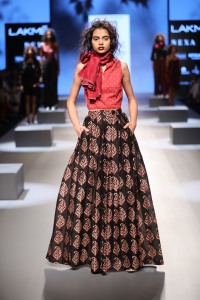 BAGH PRINTS are hand block prints using vegetable and mineral colours, primarily red and black on a white background of a textile.
BAGH PRINTS are hand block prints using vegetable and mineral colours, primarily red and black on a white background of a textile.
It is an old technique of printing practised & mastered by the Khatri community who had migrated from Sind to settle in Bagh, Dhar district of Madhya Pradesh. The river Baghini that passes through Bagh is the lifeline of the craft. The process of printing is water-intensive therefore it is dependent on the river. Besides, the high copper content in the river water gives lustre to the printed fabric. The process of printing and treatment of the fabric follows a lengthy procedure that includes preparation of colours, fabric soaking, boiling, drying, washing & printing. The artisans methodically follow elaborate steps that are water-intensive. It takes 8-10 days to print the fabric or more depending on the number of colours and design.
My Trip to Bagh in the early ’90s was the beginning of an association with the rural craft sectors.I was commissioned to design a range of clothing with Bagh printed textiles. During my visit, I was fortunate to meet the finest Master craftsman Late Shri Ismail Khatri, a Visionary who was responsible for reviving the craft & putting it on the world map. He took me through the various processes and techniques and familiarized me with the ingredients that were required in the craft.
My admiration for the printed textile was not only heightened for its aesthetics but also for the effort, workmanship and the dedication of the craft community .
Presently, I work with the grandchildren of late Shri Ismail Suleman Khatri. We together co-create & collaborate when working on textiles. They are highly skilled at their craft and are aware of the value of their work. Therefore I try to balance the craft & design in my work enhancing the workmanship.
It has been an endeavor to work towards sustainable livelihood and to work on sustainable designs.
Bandhani, the craft that my work is synonymous with.
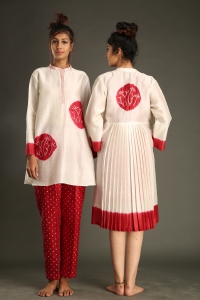 BANDHANI Or Bandhej is an ancient art of tie-dye on fabrics. It is a resist-dyeing technique that creates dotted patterns or designs. The finest Bandhani is practiced in the region of Kutch in Gujarat. Though the regional color palette is red, yellow, white and black the use of vibrant colors is popular too. The knots for the bandhani are tied by the women in the villages of Kutch in their spare time. A master dyer prints the impression of desired designs on the fabrics and distributes it to them . Once the knots are tied on the impressions it is washed and dyed into the desired color.
BANDHANI Or Bandhej is an ancient art of tie-dye on fabrics. It is a resist-dyeing technique that creates dotted patterns or designs. The finest Bandhani is practiced in the region of Kutch in Gujarat. Though the regional color palette is red, yellow, white and black the use of vibrant colors is popular too. The knots for the bandhani are tied by the women in the villages of Kutch in their spare time. A master dyer prints the impression of desired designs on the fabrics and distributes it to them . Once the knots are tied on the impressions it is washed and dyed into the desired color.
I was introduced to Kutch in 2003, selected as one of the designers to work with the craft clusters of the region. An initiative, taken by the ministry of textiles to help the artisans after the devastations caused by
The earthquake in 2001. It was the beginning of a long association with the region and the crafts. The traditional craft of bandhani provided me with the freedom to explore, adapt and create new designs for a contemporary clothing range. The craft lent itself with utmost ease and exuberance in my designs.
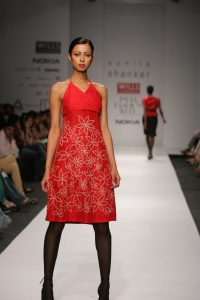 I launched my first range of clothing using bandhani in 2004, the success of the range encouraged me to decide working on bandhani crafted clothing then onwards. Faced with many challenges initially from finding the rhythm to work with the craft, working on new designs every season, reservations faced from stores and boutiques to retail the collection and finally educating both stores and clients that bandhani was equally labor and time intensive as any other hand-embellished crafts. It took a fair deal of hard work and time for the acceptance of the craft.
I launched my first range of clothing using bandhani in 2004, the success of the range encouraged me to decide working on bandhani crafted clothing then onwards. Faced with many challenges initially from finding the rhythm to work with the craft, working on new designs every season, reservations faced from stores and boutiques to retail the collection and finally educating both stores and clients that bandhani was equally labor and time intensive as any other hand-embellished crafts. It took a fair deal of hard work and time for the acceptance of the craft.
My clothing range comprises a contemporary, minimalist approach while incorporating bandhani, it may be working with motifs that I am synonymous with, combining placement design with dip-dye technique. Another range comprises of Indian wear, sarees and tunics in vibrant Indian colors of red, yellow, Indian pink and orange using elaborate traditional designs associated with bandhani.
It is the versatility of the technique that facilitates in innovating within the constraints of the craft.
Over the years one has witnessed the craft flourish and become popular. Today, many young designers are opting to work with bandhani.
Eventually, it is not about my contribution to the craft but about how the craft has enriched both my work and life.
Kantha, Embroidery from West Bengal
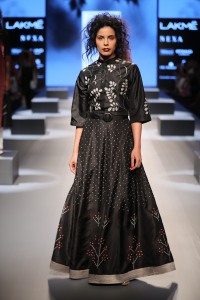 Kantha means Rags in Sanskrit. It is an ancient Hand-stitch embroidery that originated in India. Kantha is for making quilts, floor covering and other utility items for personal use by the women in the villages, by recycling old worn-out cloth.
Kantha means Rags in Sanskrit. It is an ancient Hand-stitch embroidery that originated in India. Kantha is for making quilts, floor covering and other utility items for personal use by the women in the villages, by recycling old worn-out cloth.
Old discarded faded textiles such as sarees and dhotis were piled in layers held together by running stitches along the edges. Threads were drawn out of the faded borders of the sarees and used for stitching. About 5-6 layers of old cloth are required to make a quilt.
The running stitches gave a characteristic ripple look to this work on textile.
On the textured textiles motifs inspired from nature would be embroidered. Today women work in teams making new designs and work on new fabrics. The craft is women’s craft, sustaining livelihood and empowering the rural women.
While visiting the weaving clusters in West Bengal in the mid-nineties, I came across Kantha embroidery. My curiosity for the craft led me to the clusters of 24 Parganas and Bholpur. The quiet and subtle beauty of the craft caught my attention which also reflected human ingenuity.
The prospect of the continuity and the rhythm of myriads of running stitches that can transform an old discarded piece of cloth into a work of art captivated me.
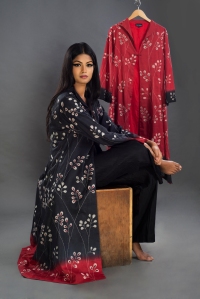 Kantha is practised by rural women to recycle old worn out sarees or dhotis to make utility items such as quilts, floor covers, bags, swaddles etc. A relevant craft when the world is addressing mindful consumption, recycling of old products, clothes and textiles.
Kantha is practised by rural women to recycle old worn out sarees or dhotis to make utility items such as quilts, floor covers, bags, swaddles etc. A relevant craft when the world is addressing mindful consumption, recycling of old products, clothes and textiles.
The craft is also known as women’s craft and has helped the rural women to develop a sustainable community.
The skillfulness of the craft allowed me to incorporate the various elements of the embroidery. Whether it was the use of textured fabric in garments or just a single motif embroidered on them, the craft lent itself to the textile, enhancing the design.
I have also used it liberally with the design embroidered, covering the entire garment without overpowering.
The continued engagement with the craft encouraged me to create a contemporary vocabulary, illustrating the versatility of the Kantha.
A brief profile: SUNITA SHANKER
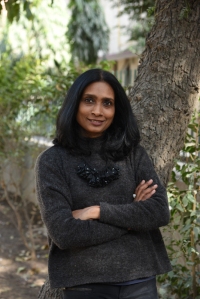 Sunita Shanker’s foray into the world of Indian handicraft and Handloom began with her visit to Madhya Pradesh in the early 90s. While working with the Bagh printers and the Chanderi weavers, she realised the need to integrate both traditional crafts with her design sensibilities in her work.
Sunita Shanker’s foray into the world of Indian handicraft and Handloom began with her visit to Madhya Pradesh in the early 90s. While working with the Bagh printers and the Chanderi weavers, she realised the need to integrate both traditional crafts with her design sensibilities in her work.
Eventually, she embarked on the journey, visiting the craft & weaving clusters in the country. Phulia in West Bengal was one of the initial weaving towns where she worked on handwoven textiles for Home furnishings and apparels. It was during her work in Bengal that she explored the areas of Bholpur and 24 Parganas for Kantha embroidery.
Her association with crafts includes her work with Chikan artisans in Lucknow,.hand block printers of, Bagh, Tarapur and of Bherogarh (M.P.) and Ajrakh( Kutch). Along with woven textiles of Varanasi(U.P) & Mangalgiri(A.P) to mention a few.
Shortly after the earthquakes in 2001 Gujarat, she found herself as a part of a selected team of designers initiated by the Ministry of Textiles to work with the craft clusters in Kutch. Her introduction to the myriad of rich craft heritage of the region left her spellbound. Her work with Bandhini culminated in a long association with the craft and the craftspeople, that her work is often synonymous with the craft.
In her career that spans over two decades, she has been able to develop a strong bond with the artisans across the country based on mutual respect and appreciation. Although it has been a long process in learning and in understanding each craft’s traditions, as well as the history and the inherent aesthetics of the craftspeople, it is just a drop in the ocean.
Sunita believes that she is fortunate to incorporate her work with traditional practices. She realises the importance of working, exploring and designing within the parameters of the craft. To her, it is crucial to maintain a balance of craft traditions and her design aesthetics in her work.
Her designs are retailed from some of the premier stores in the country and Galleries.
Aside from this, she has spoken at various forums on craft-based design and fashion, women entrepreneurship to mention a few.
She has also conducted classes at NIFT(Delhi) and has been a guest speaker on numerous occasions. She has been on the jury for National Institute of Fashion Technology and other design institutes.
For the past few years, she has helped in reviewing the curriculum regarding ‘Craft Cluster Initiative, as a special invitee on the Senate of Nift for the same. As a part of the committee to promote Handloom and Handicraft in design education.
In 2018, she was also on the committee for the selection of Sant Kabir award, the national award for the year 2017.
Recently, she has been one of the stakeholders helping in formulating a New Policy for Handloom sector for the Textile Ministry.